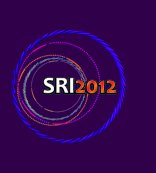-
Energy dispersive detectors
This session focuses on the developments of energy dispersive detectors.
• Pete Siddons (BNL): Developments at BNL
• Matthew Wilson(STFC): Development of Energy dispersive detectors at STFC
• Nicola Tartoni(Diamond): Development of an energy dispersive Multi-Element Germanium Detector at Diamond -
Soft x-ray area detectors
For soft x-rays area detectors very promissing concepts include direct detection with maps or CMOS imagers. This session focuses on these new developments.
• Peter Denes (LBNL): New developments at LBNL
• Cornelia Wunderer (Desy): Development of a soft x-ray area detector at Desy
• Ralf Menk (Elettra): Development of low energy Detectors at Elettra
• Michael Krumrey (PTB, Germany): Absolut calibration of X-ray detectors at low energies -
Direct detection area detectors for storage rings
This session is devoted on hybrid area detectors for applications at synchrotrons. The requirements from synchrotrons will be discussed and new developments from synchrotrons and commercial companies in this field will be shown. Included are single photon counting and charge integrating systems.
• Ian Johnson (Paul Scherrer Institut): The Eiger Project
• David Pennicard (Desy): The Lamda Project
• Julian Marchal (Diamond Light Source): The Excalibur Project
• Hidenori Toyokawa (Spring8): Detector development at Spring8
• Mark Tate (Cornell University): Detector developments at Cornell -
Interconnect and sensor technologies
This session shows the current status and near future is in the areas of interconnect technologies (through silicon vias, 3D integration, high density interconnect) and high-Z sensors for hybrid detectors.
• Fabian Hügging (Bonn University): Overview of interconnect technologies
• Paul Sellin (University Surrey) : Overview and future of high Z sensor materials for hybrid detectors -
XFEL detectors
This session presents ongoing developments for current and future X-ray free electron lasers.
• Matteo Porro (Max Planck Institut, Halbleiterlabor): The DSSC detector
• Julian Becker (DESY): The AGIPD detector
• Matt Hart (STFC): The LPD detector
• Aldo Mozzanica (Paul Scherrer Institut): Detector developments for Swissfel
• Chris Kenney (LCLS): Detector Development for LCLS
• Takaki Hatsui (Sacla): The multivia detector based on SOI technology
• Lothar Strüder (Max Planck Institut, Halbleiterlabor): Xfel detector developments at MPI -
Indirect detection
Indirect detection is usually used in applications where direct detection can not be used like low energies or highest spatial resolutions.
• Thiery Martin (ESRF): State of the art X-ray imaging cameras
• Federica Marone (PSI): Developments at the Tomcat beamline of the Swiss Light Source
Choose timezone
Your profile timezone:

